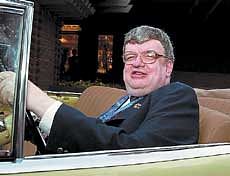
Late last month, Kim Peek suffered a heart attack and died in his hometown of Salt Lake City, Utah, USA; he was 58. One would recall that Kim was the main inspiration behind the much-admired film, Rain Man (1988), which touched the hearts of millions of viewers around the world and went on to harvest four Oscars for Best Film, Best Director (Barry Levinson), Best Actor in a leading role (Dustin Hoffman), and Best Original Screenplay (Barry Morrow and Ronald Bass).
The only film in history to win the Oscar as well as the Golden Bear at the Berlin Film Festival, Rain Man breached the top-spot at the box office and amassed a record-breaking $172 million in 1988-89.
Essentially a ‘road-movie’, it narrated the story of Charlie Babbit (played by Tom Cruise) ‘discovering’ a hitherto unknown brother, Raymond (Hoffman) who has just been willed a whopping three million dollars by their recently deceased father. Charlie is a self-centered wily sucker, and Raymond an autistic savant, and their coming together and bonding during the course of an unplanned cross-country car trip form the crux of the movie.
The main link between Kim Peek and Rain Man was Hollywood writer Morrow who met Kim and his father, Fran, in 1984 at a Conference of Association for Retarded Citizens in Texas. Morrow was not just impressed but ‘absolutely flabbergasted’ by the extraordinary powers of Kim and ‘could not simply get him out of his mind’. Inspired by Kim, Morrow wrote the story of Rain Man, and rest, as they say, is cinematic history.
Sluggish child
Born on November 11, 1951, with missing corpus callosum (the large bundle of nerves that connects the left and right hemispheres of the brain), damaged cerebellum, and a head which was 30 percent larger than normal, Kim was written off by doctors as someone who would not reach his teens. As a sluggish child who cried a lot, showed no interest in games and failed to respond to stimuli, Kim never experienced the normal stages of development.
When he was just nine months old, a doctor is said to have pronounced him mentally retarded and recommended to his parents that he be placed in a mental institution. They refused to do so. In fact, it was Fran who became Kim’s lasting friend taking care of all his needs till the very end.
How Kim — a shy and seemingly undistinguished boy — went on to become an international celebrity is a fascinating and an almost incredible story. From early childhood, despite his otherwise precarious condition, Kim displayed unusual powers of memory and incredible recall abilities which helped him read and memorise thousands of books. He could read two pages in about 10 seconds — the right page with his right eye and the left simultaneously with his left eye. He could remember phone books by heart, could tell exactly what day of the week a particular date fell over centuries, and was so incredibly gifted that he could ‘read’ things that were upside-down, sideways, or mirror-imaged.
Kim could list roads, businesses, zip codes and historical data from any American city — accurately and instantaneously. As he grew up, his areas of proficiency included American history, geography, sports (baseball, basketball and football), films, calendars and dates, and Shakespeare.
Notwithstanding all these talents, Kim found it difficult to perform ordinary tasks like buttoning up his shirts and walking up the stairs. Throughout his life, Kim completely depended on his father for such routine activities like tying the shoes or brushing the hair. For Fran, Kim was an amazing son who touched and moved by his uniqueness and naïve charm. On his part, Kim thought he and his dad ‘shared the same shadow.’
Human computer
The Journey of a Mega-Savant by Fran Peek (with Lisa Lyn Hanson/2007) provides many interesting experiences and anecdotes. “When Kim was 18, he got a job working on the payroll at the Columbus Community Center, a day workshop for adults with disabilities in Salt Lake City,” writes Fran. “Without the aid of calculators or computers, he prepared the payroll worksheet for about 160 disabled employees at the center, every week. He faithfully and flawlessly performed his job for 12 years until the State of Utah mandated that payroll and account payable data for programmes using state funds be processed through the state computer. After his payroll job was terminated, the workshop had to hire two full-time accountants to do the work he had done on a very part-time basis.”
Fran emphasises that the film Rain Man was not really about Kim, but was only inspired by him. Nevertheless, Fran acknowledges that the movie changed their lives in unimaginable ways. “It also helped change the way people in this country and round the world perceive individuals with disabilities… We have met with over three and a half million people in the past 18 years. Prior to that time, before the movie Rain Man, Kim interacted with virtually no one outside of his immediate family. His mother and I wanted to protect him, and we probably would be doing so to this day were it not for Dustin Hoffman and Rain Man screenwriter Barry Morrow who insisted that we share our very special son with the world.”
Kim and Fran toured throughout the world and inspired millions of people. Kim also attracted the attention of the scientific community which was interested in researching about his astonishing memory. In 2004, scientists from NASA even scanned his brain to understand its secrets.
When the film won him an Oscar, Morrow promptly presented the award to Kim; the statuette remained with Kim as a favourite possession throughout his life. Hoffman too did not forget to thank Kim in his award acceptance speech at the Oscars. Much earlier, after meeting Kim while preparing for the role, Hoffman was so moved by Kim that he had exclaimed, “I may be the star, but you are the heavens!”